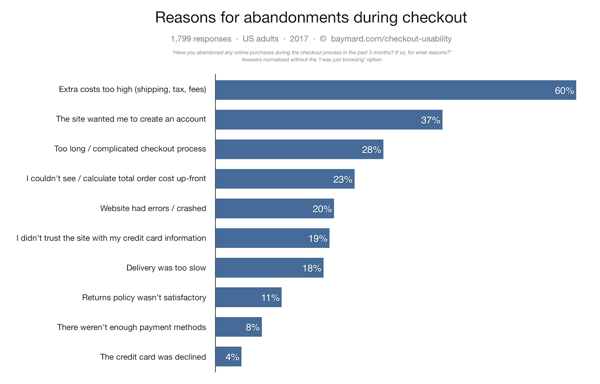
From your point-of-view, maybe your current online e-Commerce checkout process is okay but it works, so why be concerned? It not only matters, if it’s a bad experience, it can kill the sale and drive consumers away for good!
New findings from installment payment solutions provider Splitit reveals that 87 percent of consumers would exit a checkout process they find to be too burdensome, and another 55 percent would walk away from the merchant forever. There’s little room for error when designing a way to help shoppers complete their orders online.
Splitit CEO and co-founder Gil Don said when it comes to streamlining the online shopping experience, e-Commerce sites “still have work to do.”
“While consumers appreciate having options, it is essential that the checkout process is seamless, at the risk of permanently losing customers,” Don noted. “Online merchants must be sure to include clear and easy ways to enter customer details, choose delivery options and make payments, while ensuring that the process does not become cumbersome for the shopper.” Whether you use an e-Commerce platform like Shopify, Magento, WooCommerce, or BigCommerce, make sure you have automated and optimized the checkout process.
Although anyone can get frustrated with challenging checkouts, they also found some age groups tolerate them differently. Ninety percent of the 55-and-older demographic wouldn’t bother completing a bad checkout process, 7 percentage points higher than the number of Millennials who were also frustrated. “Regardless of age or cohort, few would log back on at a later time to try to complete their purchase. Just 5 percent of older consumers and 12 percent of Millennials would behave this way,” Splitit said. (The survey, conducted in July 2018, was jointly carried out with Google Consumer Surveys based on a representative sample of more than 1,000 respondents from the United States, aged 18-65+.)

Another example of what can cause frustration and abandonment at checkout is the misuse of ads inserted into the checkout process. Ads can cross over from being helpful incentives to becoming a distraction. More than a quarter (28 percent) of those ages 45 and above would abandon a checkout page or process littered with ads, while Splitit said millennials seem more tolerant: 19 percent would quit their cart because of too many advertisements. This points out the need to conduct good A/B testing of these types of informational inserts.
With online shopping expected to reach $4.88 trillion in the next three years, brands with an e-Commerce platform must design a seamless end-to-end experience that facilitates—not frustrates—order completion.
Customer Experience is THE “thing” You Must Focus On Now Across Your e-Commerce Platform
So maybe you are questioning if the Splitit findings are just one company’s insight that may not be that valuable? It’s not just Splitit, according to Gartner data, 42% of CEOs say that better customer experience (CX) was “the key change that has driven more wins.” Furthermore, for 80% of B2B customers, CX is the biggest influencer in the decision to work with a certain vendor. And, Walker insights indicate that by 2020, customer experience will overtake price and product as the key brand differentiators.
If CX is the key consideration in improving your customer’s online e-Commerce experience, what are you doing to understand it and improve it?
Are you using tools to monitor, evaluate and track a consumer’s online experience? If not, you should be. McKinsey cites observation of consumers as a crucial first step in creating better CX.
For example, one of the many tools we use in working with clients to improve their CX on their e-Commerce platforms is Lucky Orange. Part of the software allows you to see heatmaps that show you how people read and interact with your site. You can segment heatmap data by location, browser, dates, mobile users, and more. It can create recordings of every visitor and segment them so you can see exactly why visitors are not converting. This is but one tool you can use to determine if the visitor to your site is having a good user experience.
What are the key factors you should be considering in an evaluation of your checkout CX?
There are a lot of tools to help you improve your CX. Whichever of these tools you use to assist in analyzing the user journey, you will want to understand their experience from their point of view based on these factors:
- Ease of use - How easy is it for a new user to perform a task?
- Accuracy - How vulnerable to errors is the task?
- Recovery Integrity - If a user makes a mistake while doing a task, how fast can he recover?
- Instinctiveness -How obvious and easy is the task to accomplish?
- Task efficiency -Are users doing tasks with optimization?
Looking at what has worked for others in improving their CX can be very helpful. This article by Kaliegh Moore of HubSpot provides six examples of how brands can improve their online experience.
Be honest with yourself when you are looking at your e-Commerce website and check out process. Imagine yourself in the visitor’s place. How easy is it? Distracting? Irritating? What can be better? What can you do to improve their experience?
Understand that your e-Commerce website is a work in progress and needs to evolve to reflect changes visitor behavior and use over time. Your e-Commerce platform design should be one that incorporates growth driven principles.
Just like the findings by Splitit, research by HubSpot found that 80% of consumers would stop doing business with a company because of a poor customer experience. You need to be diligently checking on and improving your CX checkout experience to grow your e-Commerce business.

